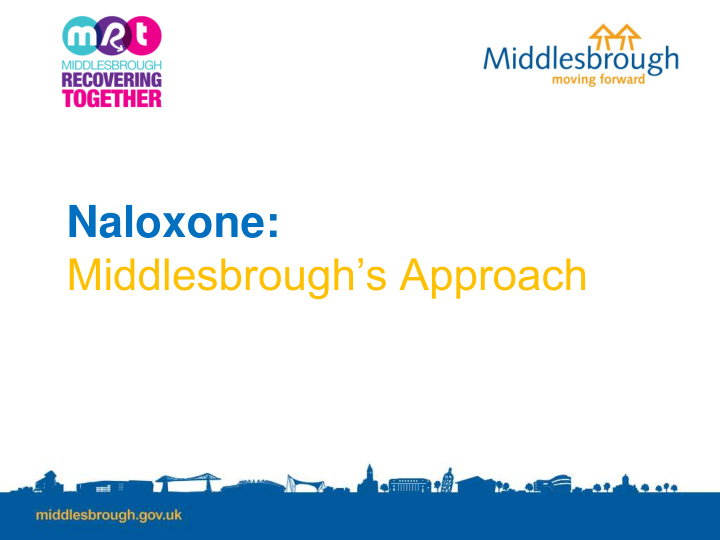



Naloxone: Middlesbrough’s Approach
Middlesbrough Local Authority is the most deprived local authority in England Middlesbrough is the Local Authority containing the highest proportion of areas which are considered the ‘most deprived’. Of the wards in Middlesbrough, North Ormesby is the most deprived, and is the second most deprived in England. 49% of areas in Middlesbrough fall into this ‘most deprived’ category, which is determined using 7 key indicators…
Deprivation Domains and Middlesbrough: Where do we sit? Income: 49% of our area is in the lowest tenth (worst in England) A Employment: 48% of our area is in the lowest tenth (second worst in England) Education: 44% of Middlesbrough is in the lowest tenth (worst in England) h Health: 56% of our area is in the lowest tenth (fifth worst in England) p Crime: 38% of Middlesbrough is in the lowest tenth (tenth worst in England) B Barriers To Housing: 0% of our area is in the lowest tenth in England (within the best) P Environment: 1% of Middlesbrough is in the lowest tenth (14 th best in England) Ranked from Worst in the country (1 st ) to Best in the country (326 th ).
Opiate Use: A National Comparison Rates of opiate users in Middlesbrough are 57% higher than in the North East region, and 66% higher than the England rate. Middlesbrough has the highest rate in the country – 21% higher than the next highest local authority. Rates are per 1,000 population and are estimates only
Opiate use in Middlesbrough The number of 9.66 users per opiate users has 14% 1,000 women increased between 2011/12 and 33.29 users per 2014/15 by: 1,000 men 2,133 2,053 1,936 Trend : 1,696 The number of users aged 15-24 61.2% of opiate has decreased by 21% in the last users are aged 4 years. 35-64 The number of users aged 25-34 has decreased by 20% in the last 33.4% aged 25-34 4 years. The number of users aged 35-64 5.4% aged 15-24 has increased by 58% in the last 4 years.
Treatment in Middlesbrough Total Naloxone/ No Treatment: 14 Estimated users in buprenorphine 691 treatment: Prescriptions: 64% In Treatment: Naloxone 1,245 11 Sub-Interventions in last 12 months: 11.4% Currently Proportion of Inject those in treatment for opiates vs 15.5% Previously non-opiates: Injected
Hospital Admissions for Substance Misuse (15 to 24 year olds) The actual number of The actual number of admissions admissions in in Middlesbrough in the latest Middlesbrough in period is: 111. 2008/09-10/11 was: 71. On average, Middlesbrough has a rate of 86 more admissions per year, per 100,000 Admissions have increased by 75% in the last 7 years. population, than England and 51 more than the North East Region.
The increase from 2012-14 Deaths Due to Drug Misuse onward is due to an increase in the number of women dying. On average, this area has 4 more deaths per year, per 100,000 population, than The actual England and 2 more than the North East number of Region. deaths in this area in the latest period is: 41. The actual Deaths have increased by 21% in the last 15 years. number of deaths in the area in 2001/03 was: 34.
Actual Deaths Related to Drug Misuse in Middlesbrough – Male and Female The increase in women dying from 2012-14 onward is highlighted above - between 2012 and 2016 it was similar to the number of men dying.
The Benefits of Naloxone Naloxone temporarily reverses the effects of opiate overdose – anyone can be trained to administer it. It only works if a person has opioids in their system – no risk of diversion. International evidence base proves its effectiveness – naloxone has saved countless lives.
Middlesbrough’s Naloxone Aims To reduce deaths. To maximise the additional benefits of our naloxone programme: • Shorter hospital admissions; No overdoses in the area without a kit available. • Awareness raising via +ve publicity; • Be pioneers to inspire other areas. Work in collaboration with all relevant partners. Train everyone who is likely to come into contact with those at risk of overdose. Flood the town with kits.
Naloxone Approach in Middlesbrough Phase One: Phase Two: • • Target those most at risk Ensure hospital is engaged • via all MRT services Extend to wider partners • • Include families/carers Kits available in key locations • • Train key partner Train as many people as organisations possible Achievements so far: • Over 1,200 kits distributed • 24 partner agencies engaged • 139 staff trained • JCUH only the 2nd hospital providing take-home kits • Lives saved
Outcomes in Middlesbrough Although impossible to quantify exact numbers, many lives have already been saved. Case study examples: 1. Foundations 2. CGL 3. Community Many more that we are unlikely to find out about…
The Future of Middlesbrough’s Programme Target more key partner organisations and locations: • Police • First responders • Transport hubs • Shopping centres • Fast food outlets • Pharmacies • Defibrilators
Thank you. Jonathan Bowden – Advanced Practitioner, South Tees Public Health jonathan_bowden@Middlesbrough.gov.uk
Recommend
More recommend